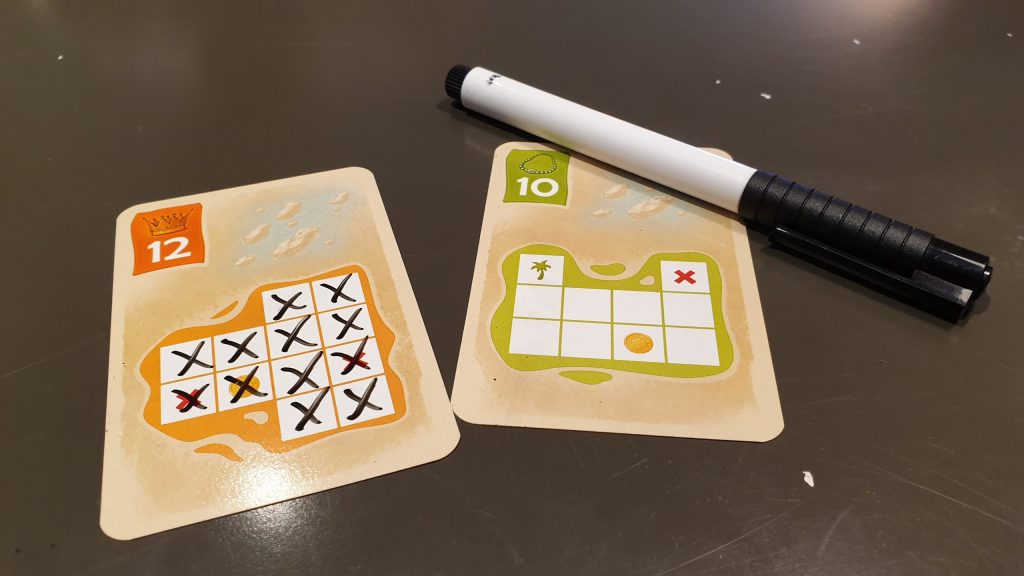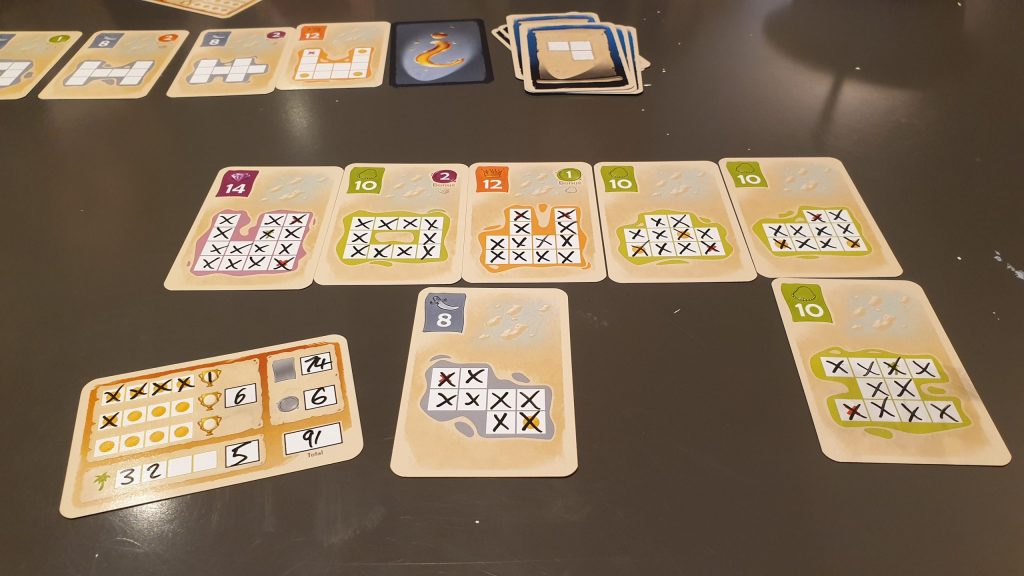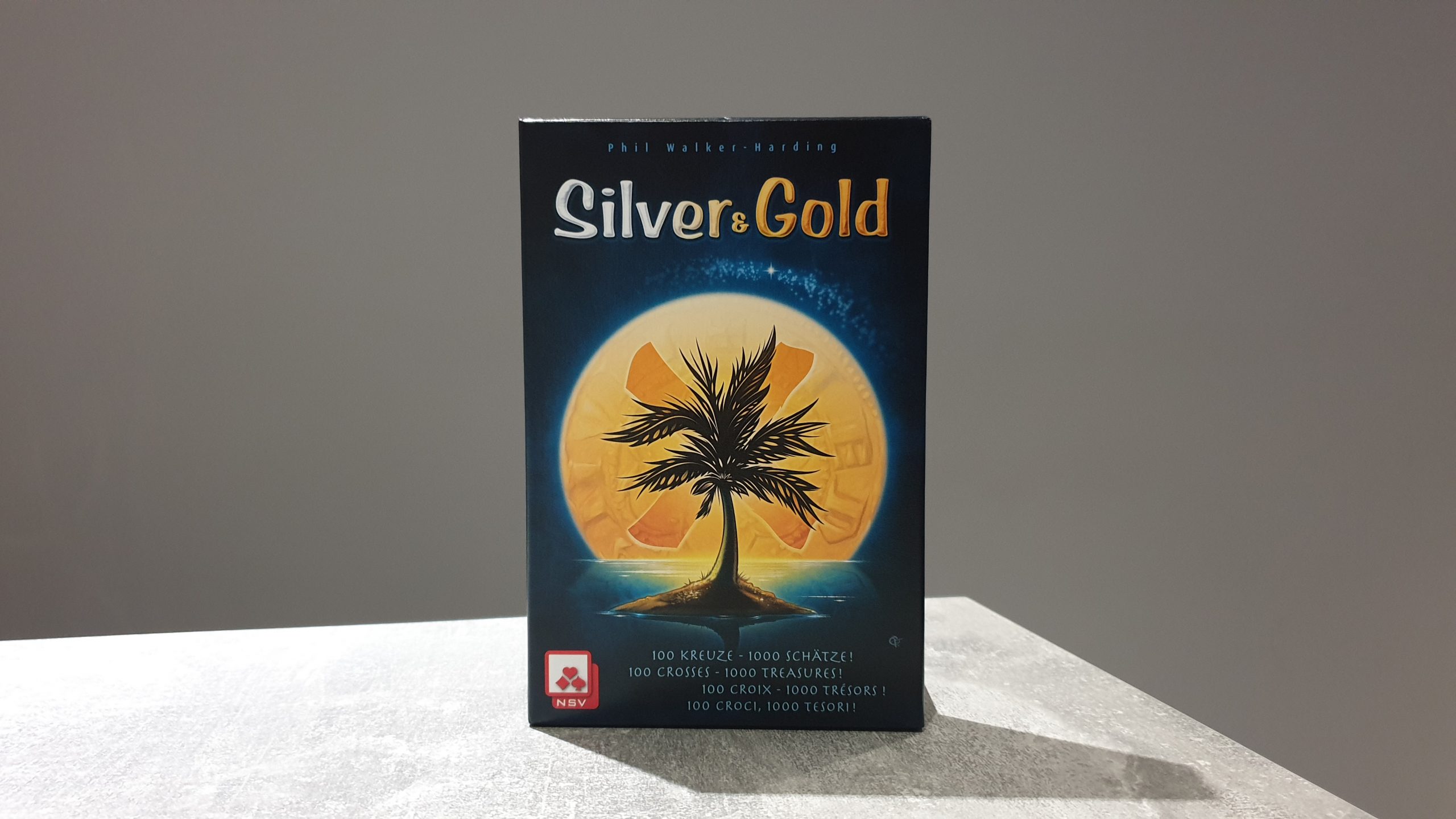Silver & Gold is the brand new roll (flip) and write style board game from renowned designer Phil Walker-Harding – the man behind games such as Barenpark and Sushi Go Party! Walker-Harding is back, teaming up with publisher Nürnberger-Spielkarten-Verlag, to bring us a treasure map themed experience for 2 – 4 players. In around 15 – 20 minutes, maps will be marked with crosses, coins and palm trees located, and many islands will have been seen. However, is this an experience to treasure? Let’s find out!
At the start of the game each player will be dealt 4 of the wipeable, island depicting, treasure cards, alongside taking a drywipe marker. Keeping two, the deck of treasure cards is shuffled, with 4 turned face up to form an available display. Each player takes a scorecard and the round card is put within sight of all players, all of which are also glossy wipeable cards.
Played out over four rounds players will be using shapes from a shuffled expedition deck to fill in the squares on their two treasure cards. On a turn the active player flips over the top expedition card. All players can then either cross off boxes on one of their treasure cards using the shape or a single square. Note that all shapes can be rotated or mirrored. The entire shape must fit. Else, the player is forced to take the second option of crossing off a single square.

There are three potential bonus symbols across the treasure cards. These trigger whenever they are crossed off. The first is a gold coin. This treasure gives you 1 victory point at the end of the game – plus collecting four coins awards a bonus trophy. These trophies start out being worth 6 points, though the value dwindles as they are claimed. Palm trees can also be found on the islands. Crossing these off scores 1 point on their own +1 for each palm tree visible in the display line. While X normally marks the spot, in Silver & Gold crossing off an X awards the player with the bonus of crossing off any single square. Note, it is more than possible for this to then trigger further bonuses.
Starting with the active player each player that has completed one of their treasure cards takes a new card from the available display. The display is maintained at four cards, with new cards from the treasure deck filling the emptied slots. Play then continues with the next clockwise player becoming the active player. 7 of the 8 expedition cards are flipped each round. The round track card shows the shapes on the cards, allowing players to guess what might be coming up. As one card is not used each round there is always some uncertainty though.
At the end of the round the current round number is crossed off on the round tracker. All of the expedition cards are reshuffled and the next round begins with the next player. Nothing changes based upon the round, with the same process followed. At the end of the game players gain points for completed treasure cards, bonuses scored on completed treasure cards, crossed off coins, trophy bonus points and points awarded by palm trees. Whoever has the most points wins, with ties split by whomever has completed the most grey (the least valuable) treasure cards.
Despite some examples in the rulebook it can be slightly hard for some to see quite how the gameplay works, including scoring elements during play. This is somewhat to do with how the rulebook has been translated making it occasionally flow oddly. Thankfully, any hesitation instantly disappears when playing. Getting into the flow of flipping a card and trying to squeeze it onto a treasure card feels natural, with the polyomino style Tetris puzzle very logical.

Once playing everyone gets stuck into the puzzle and rarely do players not get overly excited about the shapes. As the game end approaches players will be desperate for a perfect shape to come up. They’ll cheer as if it were treasure when it does or groaning when a shape they could have used turns ago finally appears. For such a small sized game it certainly packs in the tension. Some of this hopefulness is built up by the knowledge available. Players know what shapes are in the deck and how frequent they are. Whilst allowing players to plan for what might come up, it enables them to pray for shapes too.
After a while it is as if the cards need a good scrub. Over time even with wiping them down each game the pen ink seems to build up into a dirty looking layer. It isn’t something that is overly avoidable, unless you sit down with each card with a proper wipe. If this is something that has irritated you about other games in the roll and write genre, when it is the cards not just player boards it may bug you more. To make matters worse the game doesn’t provide a cloth or eraser style pen end, as seen in Railroad Ink, to help keep the components cleaner for longer.
Taking two hot trends of polyominoes and the role and write genre, Phil Walker-Harding was certainly onto more than just crossing off the current hotness. Silver & Gold’s cards do get a bit dirty. However, this is only because players will want to keep playing, making the components that way. The gameplay is extremely easy to teach, with the scoring becoming more obvious within a round of play. As far as roll and writes, or flip in this case, Silver & Gold offers a short unique but exciting experience.
(Editor’s Note: Silver & Gold was provided to us by Coiledspring Games for the review. The game is currently available from local board game stores.)

